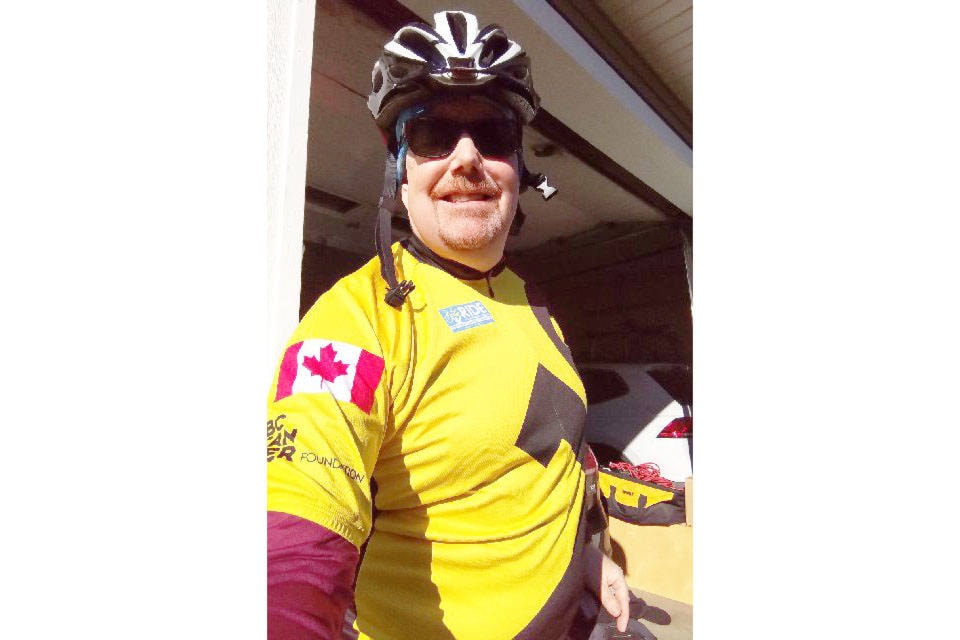According to the Canadian Cancer Society, squamous cell carcinoma (SCC) is the second most common skin cancer. It usually manifests in areas that have been exposed to the sun.
Former Comox Mayor Paul Ives knows about it all too well. He’s been in the recovery stages of his cancer battle for nearly a year now.
“I call it a journey,” said Ives. “It goes back to about 2013, when I started to notice lesions on the side of my face, and one, in particular, that wasn’t really healing. It would scab over, peel off, scab over, peel off, and it started getting bigger. So I got it biopsied and they said it was a basal cell skin cancer and I had to get it surgically removed. I had one in the middle of my back about 10 years ago so I thought ‘OK, I know what’s involved here’ and thought nothing more of it.”
This time, it wasn’t as simple.
A couple of weeks after his procedure, a follow-up biopsy determined it was not fully removed.
“We did that two more times and finally the surgeon said ‘look, this is something more than meets the eye. It’s probably gone a little deeper and a little broader than we thought.”
In 2018 Ives was sent to Vancouver for Mohs surgery - a procedure
to remove part of the lesion, then analyze it immediately.
“It makes for a long day,” said Ives. “It’s like sitting in the dentist chair for 12 hours.
“It was quite a journey that day. It was like ‘OK well hopefully that got it all’ because that was quite a procedure.”
Six months later Ives returned to Vancouver, where the doctor spotted another lesion just above his right ear, leading to another biopsy.
“This time it proved to be the more aggressive type of skin cancer… the squamous cell.”
Ives ended up at the Royal Jubilee in Victoria for surgery in April of 2019. He had a 2” wide by 1” high by half-inch deep chunk removed from his face, patched with a graft from his shoulder.
The cancer returned in June.
The next step was to try radiation: five days a week, for five weeks.
That procedure took place in Victoria, last summer.
“Initially you don’t feel a whole lot, but the radiation treatment… kind of has a cumulative effect on you. Your energy levels drop as you get deeper into it,” said Ives.
His final radiation treatment was Aug. 21 and to this point, the cancer has not returned.
“Since then, it has been a healing process… it’s like having a bad sunburn on the side of my face. The side of my face is quite red, and where the very aggressive radiation was happening there is still a small scab there today… I just keep an eye on that.”
His last scan was in March. He remains on a ‘watch’ list.
“At this point, I just hope that’s the end of it,” said Ives. “Now it’s all about taking all the precautions that we know are important, to stay safe from the sun, stay out of the midday sun, and go back to whatever the new normal is with that. I know a lot of people have been through a lot worse, but that’s what I have gone through.”
Ives said while it isn’t certain exposure to the sun caused his cancer, he figures the chances are likely.
“My complexion, I call it the Celtic complexion - red hair, freckles as a kid, growing up, running around the beaches of PEI and Nova Scotia… didn’t wear hats, didn’t wear sunscreen, we just got burned,” he said. “So I suspect it had a lot to do with the exposure to the sun.
“So now I wear a hat with a bandanna around my ears, make sure I lather in sunscreen for the other parts that might be exposed, wear long sleeves, all those kinds of things.”
Ives said protection from the sun should be a life-long procedure.
“Absolutely. We know more about it now than we ever did. Being sun safe is being promoted quite a bit.
“I will probably never be out of the woods with this thing. I will always have to keep an eye on things, or as I like to say, bad pun intended, ‘play it by ear.’ ”
He said the most important thing to take away from his experience is to pay attention to the signs, and act on them immediately.
“The message is not to let things get away from you. I suppose … most men kind of ignore these things, until all of a sudden it becomes more involved. We have the attitude that ‘that’ll just go away.’ Well, it doesn’t always.”
For more information on squamous cell carcinoma, contact the Canadian Cancer Society, at 1-888-939-3333, or visit cancer.ca
***
Ives and his friend Ryan Sykes have been in training for the 2020 Ride to Conquer Cancer, which announced its postponement Monday night, due to the COVID-19 pandemic.
Although the ride itself has been cancelled, Ives said he will continue his training and fundraising for the cause.
“Ryan Sykes and I were going to ride in support of a young boy from Comox who is being treated for acute lymphoblastic leukemia,” said Ives. “I still plan to train and to fundraise as my way of giving back to BC Cancer Foundation and BC Cancer Centre in Victoria.”
To donate to Ives’ fundraising page, go to https://bit.ly/3cImaRj
ALSO: Doctor urges sunscreen use to prevent skin cancer
terry.farrell@blackpress.ca
Like us on Facebook and follow us on Twitter
